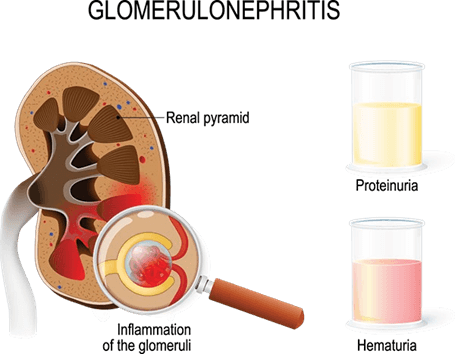A nurse is collecting data from a child who has acute glomerulonephritis.
Which of the following findings should the nurse expect?
Decreased blood pressure
Pale yellow urine
Periorbital edema
Increased urination
The Correct Answer is C
c. Periorbital edema.
Explanation: Acute glomerulonephritis is an inflammatory condition affecting the glomeruli of the kidneys. It is commonly characterized by periorbital edema, which is swelling around the eyes. This occurs due to fluid retention and impaired kidney function. Other common manifestations of acute glomerulonephritis include hypertension (increased blood pressure), dark or tea-colored urine (hematuria), decreased urine output, and signs of fluid overload such as edema in the hands, feet, and face.
Option a, decreased blood pressure, is not typically seen in acute glomerulonephritis. Instead, hypertension is a common finding due to fluid retention and increased blood volume.
Option b, pale yellow urine, is not expected in acute glomerulonephritis. Instead, urine may appear dark or
tea-colored due to the presence of blood (hematuria).
Option d, increased urination, is not a characteristic finding in acute glomerulonephritis. Instead, there is often a decrease in urine output or oliguria.
It is important to note that individual presentations may vary, and the nurse should consider the complete clinical picture and the child's specific symptoms when assessing for acute glomerulonephritis.

Nursing Test Bank
Naxlex Comprehensive Predictor Exams
Related Questions
Correct Answer is D
Explanation
The nurse should expect to find hyperkalemia in the medical record of a client who has sustained a full- thickness burn and is in the emergent phase of the burn. This is due to the release of potassium from damaged cells into the bloodstream.
a) Hypernatremia is not a common finding in the emergent phase of a burn.
b) Hypercalcemia is not a common finding in the emergent phase of a burn.
c) Hypermagnesemia is not a common finding in the emergent phase of a burn.
Correct Answer is C
Explanation
Answer: C. Weigh the client each morning after voiding
Rationale:
A. Encourage the client to gain 2.3 kg (5 lb) per week:
A weight gain goal of 0.5 to 1 kg (1 to 2 lb) per week is considered safe and realistic. Gaining 2.3 kg (5 lb) weekly is too aggressive and may cause physical and psychological stress for the client.
B. Monitor the client for 15 min after meals:
Clients with anorexia nervosa are at risk for purging behaviors. Monitoring for only 15 minutes is insufficient. A 60-minute post-meal observation period is more appropriate to deter vomiting or excessive exercise.
C. Weigh the client each morning after voiding:
Daily weights, taken at the same time each morning after voiding and before eating, provide consistent and accurate data to monitor progress and detect manipulation or fluid shifts.
D. Reinforce teaching about healthy eating during meals:
Reinforcing education during meals can increase the client’s anxiety and resistance to eating. Teaching is best done separately from mealtimes to avoid associating eating with stress.
Whether you are a student looking to ace your exams or a practicing nurse seeking to enhance your expertise , our nursing education contents will empower you with the confidence and competence to make a difference in the lives of patients and become a respected leader in the healthcare field.
Visit Naxlex, invest in your future and unlock endless possibilities with our unparalleled nursing education contents today
Report Wrong Answer on the Current Question
Do you disagree with the answer? If yes, what is your expected answer? Explain.
Kindly be descriptive with the issue you are facing.
